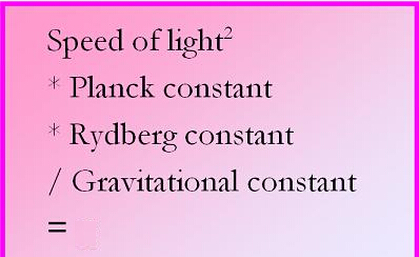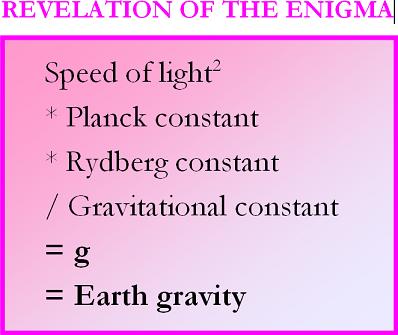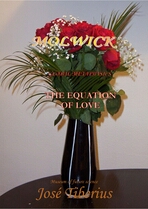3.b.2. The Gravity Riddle and the Equation of Love
It all started a long time ago.
Sensing something elemental did not fit.
Looking for solid arguments to help the presentation of the Equation of Love because Global Physics did not exist at the time, I searched for some relationship of the main magnitudes. Of course, I also mused of apples, pears, and other exotic fruits as a classic source of inspiration.
To get an objective touch, I asked David and Goliath, and they gave back the following constants: speed of light c, Gravitation constant G, and Planck’s constant h.

For this research, we added the Rydberg constant R because it appeared in a pre-college physics book, wanting to become familiar with the combined quantities of said physical constants or transformation ratios.
The fact is that when multiplying them and checking the intermediate quantities, it could be due to the uncommented sources of inspiration or pure luck, the experiment paid off. We found much more than we were looking for: a riddle that could attract attention.
This enigma is so strange that after offering the result, nobody seems to be convinced.
Even though to resolve this problem we only need to multiply the speed of light *c* with the Planck constant *h* with the Rydberg constant *R* and with a Molwick. Knowing one Molwick is equal to the speed of light *c* divided by the constant of the gravity of Newton *G.*
There was also a surprise; in addition to the physical constants mentioned, a non-invited variable turned up.
?? = c² * h * R / G
* *
Among the most surprising comments about the Gravity Riddle from science experts –Physics, Chemistry, and other–, it is worth highlighting the following:
It is a coincidence
It is not easy to maintain this idea because the difference between the two values of gravity on the surface of the Earth g of thousandths. Besides, that would be like a proton winning the lottery, not just the first prize but the whole universe since the quantities involved in the physics constants exceed the number of existing protons in the whole of the universe. According to non-serious quantum estimates, it would be a quantity of the order of 1080, –also somewhat metaphysical without a doubt.
Another argument against the chance as a recourse to the unknown is that the physical constants involved have a clear physical interrelation. Moreover, it would be embarrassing to maintain that the discovery of a causal relationship was by chance when investigated in the specific place where it was.
The result of the riddle is not exact because it does not match with gravity acceleration *g* on the Earth’s surface.
Of course, a slight quantum slips up since it is common knowledge that gravity acceleration on the earth’s surface is variable according to the radius, the geometry of the land, and the latitude due to the effect of the centrifugal force of the Earth’s rotation.
We would need to verify the decimals of physical constants in the formula for the Riddle of the Gravity.
I had a similar comment in the new and much simpler explanation of Global Physics of the anomalous precession of the orbit of the planet Mercury. Which said that the value for the sun’s mass could be wrong because was not from the official charts, being the same value of Einstein when explaining the same precession stretching time and space.
In the case of the riddle of the Gravity of Love enigma, it could the opposite, because the knowledge of this formula could help accurately calibrating the decimals of the physics constants.
There are problems with the dimensions
If it put directly forth, there might be a problem, but as we showed on the previous page about gravity acceleration, this problem does not exist. Besides, the problem could be the dimensions of the current physics constants such as the units of the constant of gravitation, which do not precisely take into account the new effect demonstrated by the Equation of Love as well as the Gravity Riddle.
Anyway, a first alternative that seems artificial and incorrect may be to include a constant with value one purely for dimensional normalization; however, it allows us to analyze the existing differences. This new constant N should be equal to:
N = 1 (m / s kg²)
A conceptual utility of the new and artificial constant N of normalization arises almost immediately. Its dimensions are those of the relationship between the constant of Universal Gravitation and Planck’s constant (G/h). They are not as arbitrary as one might expect. At the same time, these physical units tell us that it is a relationship between the basic configurations of gravity and energy.
The Riddle of Gravity or Gigachron experiment would look like:
[1] g = c² * h * R * N / G
And now, with coherent units:
m/ s² = (m / s)² * (1 / m ) * (m / s kg²) * (kg m² / s) * (kg s² / m³)
A basic error due to the vector magnitudes not included in the formula as such.
It is true, but it is easy to solve it just by drawing a little arrow over the vector magnitudes, as done by the pure Physics books.
These observations had good intention since it would have been easier to say that perhaps the Gravity Riddle was important. The conclusion is that the more educated in science a person is, the more reluctant is to admit science big mistakes and especially if they come from the field of theoretical research and not from experimentation.
Of course, they cannot come from empirical evidence because if a simple addition or multiplication is not accepted, how are they going to accept possible logical reinterpretations of experiments and known natural phenomena. In other words, the riddles and scientific experiments allowed are those not contradicting the apparent paradigm.
* * *
The Riddle of Gravity –or GigaChron experiment– is dealt with further mathematical development in the next section of fundamental constants, studying its relation with the Equation of Love, its relationships with the Law of Gravity of Newton, and some additional curiosities, such as the relationship between the mass and charge of the electron with the mass and radius of the Earth.
As strange as the origin of the Love Equation and the Gravity Riddle may seem, they are independent, three years difference and both are quite fortuitous. So much, that from their origin, one belongs to the world of metaphysics and the other of physics.
The Equation of Love is pure metaphysics, but it helps the brain to understand the possible relations between several fundamental physics constants.

Substituting time squared from its value in the equation E = m c², we end up with Newton’s equation for gravity acceleration, which would be equal to love times energy.
g = L * E
Inversely, we would get the same in this formula if in Newton’s equation for gravity acceleration we substitute mass with its value by clearing Einstein’s E= m c² equation –originally from Olinto de Pretto.
g = G * (t² / e4)* E
The Equation of Love has been the source of metaphysical inspiration for seeking the relations between the fundamental constants that puts forth the Gravity Riddle or experiment GigaChron. It leads to the essential formula of the Global Physics since it states the equivalences and relations between the primary magnitudes.
We have already seen that the unit of Love of one Molwick was equal to *c/G*. Also, if we keep in mind that *chR* is equal to the energy of the photon given off by the hydrogen atom on the Earth’s surface; we are left with the solution of the Gravity Riddle; once the appropriate multiplication is carried out, which is the following:

* * * *
At least one of the constants involved in the Gravity Riddle contains the information to the relation between the Earth’s mass and its radius squared, a slightly variable magnitude. Which could it be?
As the speed of light, Planck constant, and the Universal Gravitational constant seem quite constant in the Solar system; the Rydberg constant should have a different value on the moon in direct proportion to the difference of gravity, that is, 0.165 times that of the Earth.
In any case, the following should be noted:
The speed of light in a post-Newtonian context is not constant and that is why Relativity needs to transform it in order for its axiom to be fulfilled. The axioms cannot be proved!
The constant G is not constant in either Global Physics or Relativity, as explained in the Last Dolphin Paradox of the Global Astrophysics and Cosmology book.
Also in atomic distances, it changes a bit –even the sign!
The modulation of the constant of Gravitation and the Rydberg constant explain the theory of the Global Atom and its electronic configuration.
In the book Law of Global Gravity, appears the Riddle of Gravity but under the name of GigaChron experiment. It is reformulated to present the underlying relations or the Gravitational Law of the Equivalence [ g = ( E c /G) * n ] regarding a slightly different perspective of the gravitational interaction within absolute time and space.
Another reformulation provides the Law of Global Gravity, which allows explaining the orbit of Mercury in a post-Newtonian context.
